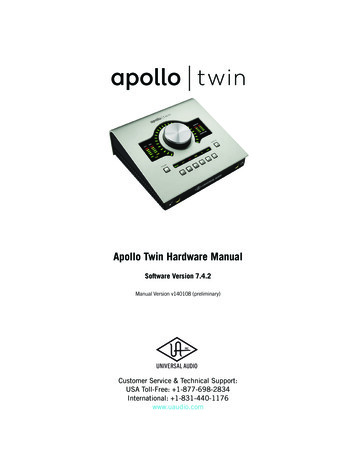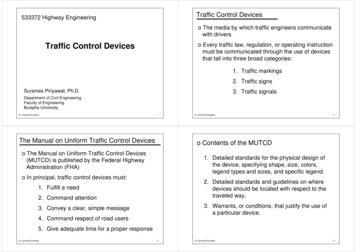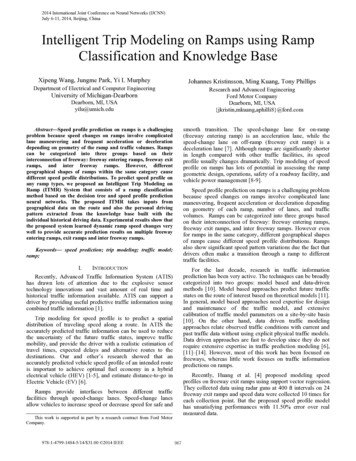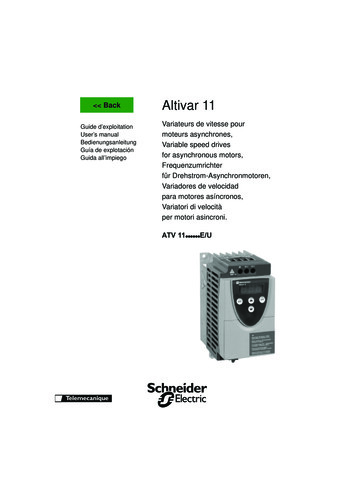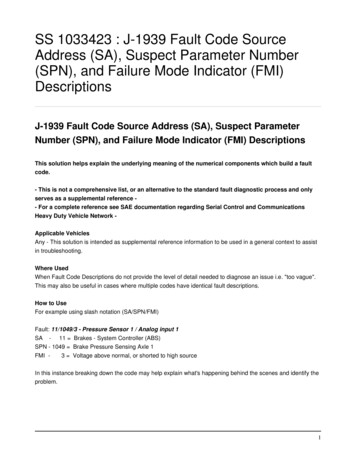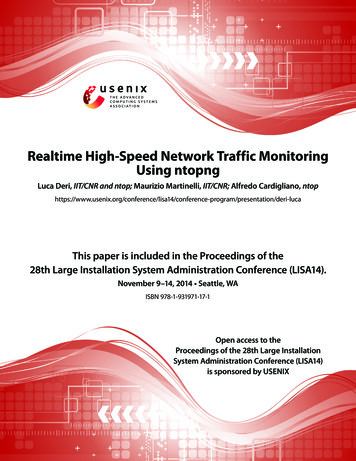
Transcription
Realtime High-Speed Network Traffic MonitoringUsing ntopngLuca Deri, IIT/CNR and ntop; Maurizio Martinelli, IIT/CNR; Alfredo Cardigliano, rence-program/presentation/deri-lucaThis paper is included in the Proceedings of the28th Large Installation System Administration Conference (LISA14).November 9–14, 2014 Seattle, WAISBN 978-1-931971-17-1Open access to theProceedings of the 28th Large Installation System Administration Conference (LISA14)is sponsored by USENIX
Realtime High-Speed Network Traffic Monitoring Using ntopng!!!!AbstractLuca Deri, IIT/CNR, ntop Maurizio Martinelli, IIT/CNRAlfredo Cardigliano, ntopMonitoring network traffic has become increasinglychallenging in terms of number of hosts, protocol proliferation and probe placement topologies. Virtualisedenvironments and cloud services shifted the focus fromdedicated hardware monitoring devices to virtual machine based, software traffic monitoring applications.This paper covers the design and implementation ofntopng, an open-source traffic monitoring applicationdesigned for high-speed networks. ntopng’s key features are large networks real-time analytics and the ability to characterise application protocols and user trafficbehaviour. ntopng was extensively validated in variousmonitoring environments ranging from small networksto .it ccTLD traffic analysis.!1. IntroductionNetwork traffic monitoring standards such as sFlow [1]and NetFlow/IPFIX [2, 3] have been conceived at thebeginning of the last decade. Both protocols have beendesigned for being embedded into physical networkdevices such as routers and switches where the networktraffic is flowing. In order to keep up with the increasing network speeds, sFlow natively implements packetsampling in order to reduce the load on the monitoringprobe. While both flow and packet sampling is supported in NetFlow/IPFIX, network administrators try toavoid these mechanisms in order to have accurate trafficmeasurement. Many routers have not upgraded theirmonitoring capabilities to support the increasing numbers of 1/10G ports. Unless special probes are used,traffic analysis based on partial data results in inaccurate measurements.Physical devices cannot monitor virtualised environments because inter-VM traffic is not visible to thephysical network interface. Over the years however,virtualisation software developers have created virtualnetwork switches with the ability to mirror networktraffic from virtual environments into physical Ethernetports where monitoring probes can be attached. Recently, virtual switches such as VMware vSphere Distributed Switch or Open vSwitch natively support NetFlow/sFlow for inter-VM communications [4], thusUSENIX Associationfacilitating the monitoring of virtual environments.These are only partial solutions because either v5 NetFlow (or v9 with basic information elements only) orinaccurate, sample-based sFlow are supported. Networkmanagers need traffic monitoring tools that are able tospot bottlenecks and security issues while providingaccurate information for troubleshooting the cause. Thismeans that while NetFlow/sFlow can prove a quantitative analysis in terms of traffic volume and TCP/UDPports being used, they are unable to report the cause ofthe problems. For instance, NetFlow/IPFIX can be usedto monitor the bandwidth used by the HTTP protocolbut embedded NetFlow probes are unable to report thatspecific URLs are affected by large service time.Today a single application may be based on complexcloud-based services comprised of several processesdistributed across a LAN. Until a few years ago webapplications were constructed using a combination ofweb servers, Java-based business logic and a databaseservers. The adoption of cache servers (e.g. memcacheand redis) and mapReduce-based databases [5] (e.g.Apache Cassandra and MongoDB) increased the applications’ architectural complexity. The distributed natureof this environment needs application level informationto support effective network monitoring. For example,it is not sufficient to report which specific TCP connection has been affected by a long service time withoutreporting the nature of the transaction (e.g. the URL forHTTP, or the SQL query for a database server) thatcaused the bottleneck. Because modern services usedynamic TCP/UDP ports the network administratorneeds to know what ports map to what application. Theresult is that traditional device-based traffic monitoringdevices need to move towards software-based monitoring probes that increase network visibility at the userand application level. As this activity cannot be performed at network level (i.e. by observing traffic at amonitoring point that sees all traffic), software probesare installed on the physical/virtual servers where services are provided. This enables probes to observe thesystem internals and collect information (e.g. what user/process is responsible for a specific network connection) that would be otherwise difficult to analyse outside the system’s context just by looking at packets.28th Large Installation System Administration Conference (LISA14) 69
Network administrators can then view virtual and cloudenvironments in real-time. The flow-based monitoringparadigm is by nature unable to produce real-time information [17]. Flows statistics such as throughput canbe computed in flow collectors only for the duration ofthe flow, which is usually between 30 and 120 seconds(if not more). This means that using the flow paradigm,network administrators cannot have a real-time trafficview due to the latency intrinsic to this monitoring architecture (i.e. flows are first stored into the flow cache,then in the export cache, and finally sent to the collector) and also because flows can only report averagevalues (i.e. the flow throughout can be computed bydividing the flow data volume for its duration) thus hiding, for instance, traffic spikes.The creation of ntopng, an open-source web-basedmonitoring console, was motivated by the challenges ofmonitoring modern network topologies and the limitations of current traffic monitoring protocols. The maingoal of ntopng is the ability to provide a real-time viewof network traffic flowing in large networks (i.e. a fewhundred thousand hosts exchanging traffic on a multiGbit link) while providing dynamic analytics able toshow key performance indicators and bottleneck rootcause analysis. The rest of the paper is structured asfollow. Section 2 describes the ntopng design goals.Section 3 covers the ntopng architecture and its majorsoftware components. Section 4 evaluates the ntopngimplementation using both real and synthetic traffic.Section 5 covers the open issues and future work items.Section 6 lists applications similar to ntopng, and finally section 7 concludes the paper.!2. ntopng Design Goalsntopng’s design is based on the experience gained fromcreating its predecessor, named ntop (and thus the namentop next generation or ntopng) and first introduced in1998. When the original ntop was designed, networkswere significantly different. ntopng’s design reflectsnew realities: Today’s protocols are all IP-based, whereas 15 yearsago many others existed (e.g. NetBIOS, AppleTalk,and IPX). Whereas only limited non-IP protocol support is needed, v4/v6 needs additional, and more accurate, metrics including packet loss, retransmissions,and network latency. In the past decade the number of computers connected to the Internet has risen significantly. Modernmonitoring probes need to support hundreds of thousand of active hosts. While computer processing power increased in thelast decade according to the Moore’s law, system architecture support for increasing network interfacespeeds (10/10 Mbps to 10/40 today) has not alwaysbeen proportional. As it will be later explained it isnecessary to keep up with current network speedswithout dropping packets. While non-IP protocols basically disappeared, application protocols have significantly increased and theystill change rapidly as new popular applications appear (e.g. Skype). The association UDP/TCP portwith an application protocol is no longer static, sounless other techniques, such as DPI (Deep PacketInspection) [6] are in place, identifying applicationsbased on ports is not reliable. As TLS (Transport Layer Security) [7] is becomingpervasive and no longer limited to secure HTTP, network administrators need partial visibility of encrypted communications. The HTTP protocol has greatly changed, as it is nolonger used to carry, as originally designed, hypertextonly. Instead, it is now used for many other purposesincluding audio/video streaming, firewall trespassingand in many peer-to-peer protocols. This means thattoday HTTP no longer identifies only web-relatedactivities, and thus monitoring systems need to characterise HTTP traffic in detail.In addition to the above requirements, ntopng has beendesigned to satisfy the following goals: Created as open-source software in order to let usersstudy, improve, and modify it. Code availability is nota minor feature in networking as it enables users tocompile and run the code on heterogeneous platformsand network environments. Furthermore, the adoptionof this license allows existing open-source librariesand frameworks to be used by ntopng instead of coding everything from scratch as it often happens withclosed-source applications. Operate at 10 Gbit without packet loss on a networkbackbone where user traffic is flowing (i.e. averagepacket size is 512 bytes or more), and support at least3 Mpps (Million Packets/sec) per core on a commodity system, so that a low-end quad-core server maymonitor a 10 Gbit link with minimal size packets (64bytes). All monitoring data must be immediately available,with traffic counters updated in real-time withoutmeasurement latency and average counters that areotherwise typical of probe/collector architectures. Traffic monitoring must be fully implemented insoftware with no specific hardware acceleration re-70 28th Large Installation System Administration Conference (LISA14)USENIX Association
quirements. While many applications are now exploiting GPUs [8] or accelerated network adapters[9], monitoring virtual and cloud environments requires pure software-based applications that have nodependency on specific hardware and that can be migrated, as needed, across VMs. In addition to raw packet capture, ntopng must support the collection of sFlow/NetFlow/IPFIX flows, sothat legacy monitoring protocols can also be supported. Ability to detect and characterise the most popularnetwork protocols including (but not limited to)Skype, BitTorrent, multimedia (VoIP and streaming),social (FaceBook, Twitter), and business (Citrix, Webex). As it will be explained below, this goal has beenachieved by developing a specific framework insteadof including this logic within ntopng. This avoids theneed of modifying ntopng when new protocols areadded to the framework. Embedded web-based GUI based on HTML5 anddynamic web pages so that real-time monitoring datacan be displayed using a modern, vector-based graphical user interface. These requirements are the foundation for the creation of rich traffic analytics. Scriptable and multi-threaded monitor engine so thatdynamic web pages can be created and accessed bymultiple clients simultaneously. Efficient monitoring engine not only in terms ofpacket processing capacity, but in its ability to operateon a wide range of computers, including low-powerembedded systems as well as multi-core high-endservers. Support of low-end systems is necessary inorder to embed ntopng into existing network devicessuch as Linux-based routers. This feature is to provide a low-cost solution for monitoring distributedand SOHO (Small Office Home Office) networks. Ability to generate alerts based on traffic conditions.In particular the alert definition should be configurable my means of a script, so that users can definetheir own conditions for triggering alerts. Integration with the system where traffic is observed,so that on selected servers, it is possible to correlatenetwork events with system processes.The following section covers in detail the ntopng software architecture and describes the various componentson which the application is layered.!3. ntopng Software Architecturentopng is coded in C which enables source codeUSENIX Associationportability across systems (e.g. X86, MIPS and ARM)and clean class-based design, while granting high execution speed.Web BrowserLog ManagersWeb AppsLog FilesSyslogJSONWeb-ServerData ExportLua-based Scripting EngineMonitoring EnginenDPILibpcapPF RINGRedisJSONIncoming Packets(Raw Traffic)nnProbe1. ntopng ArchitectureNetwork Events(e.g. Firewall)NetFlow/IPFIX, sFlowntopng is divided in four software layers: Ingress data layer: monitoring data can be raw packets captured from one or more network interfaces, orcollected NetFlow/IPFIX/sFlow flows after havingbeen preprocessed. Monitoring engine: the ntopng core responsible forprocessing ingress data and consolidating trafficcounters into memory. Scripting engine: a thin C software layer that exports monitoring data to Lua-based scripts. Egress data layer: interface towards external application that can access real-time monitoring data.3.1. Ingress Data LayerThe ingress layer is responsible for receiving monitoring data. Currently three network interfaces are implemented: libpcap Interface: capture raw packets by means ofthe popular libpcap library. PF RING Interface: capture raw packets using theopen-source PF RING framework for Linux systems[10] developed by ntop for enhancing both packetcapture and transmission speed. PF RING is dividedin two parts: a kernel module that efficiently interactswith the operating system and network drivers, and auser-space library that interacts with the kernel mod-28th Large Installation System Administration Conference (LISA14) 71
ule, and implements an API used by PF RING-basedapplications. The main difference between libpcapand PF RING, is that when using the latter it is possible to capture/receive minimum size packets at 10Gbit with little CPU usage using commodity networkadapters. PF RING features these performance figures both on physical hosts and on Linux KVM-basedvirtual machines, thus paving the way to line-rateVM-based traffic monitoring. ØMQ Interface. The ØMQ library [12] is an opensource portable messaging library coded in C thatcan be used to implement efficient distributed applications. Each application is independent, runs on itsown memory space, and it can be deployed on thesame host where ntopng is running, or on remotehosts. In ntopng it has been used to receive trafficrelated data from distributed systems. ntopng createsa ØMQ socket and waits for events formatted asJSON (JavaScript Object Notation) [16] strings encoded as “ element id ”: “ value ”, where elementid is a numeric identifier as defined in the NetFlow/IPFIX RFCs. The advantages of this approach withrespect of integrating a native flow collector, aremanyfold : The complexities of flow standards are not propagated to ntopng, because open-source applicationssuch as nProbe [13] act as a proxy by convertingflows into JSON strings delivered to ntopng viaØMQ. Any non-flow network event can be collected usingthis mechanism. For instance, Linux firewall logsgenerated by netfilter, can be parsed and sent tontopng just like in commercial products such asCisco ASA.Contrary to what happens with flow-based tools wherethe probe delivers flows to the collector, when usedover ØMQ ntopng acts as a consumer. As depicted inFig 1., ntopng (as flow consumer) connects to nProbe(that acts as flow producer) that acts as flow probe orproxy (i.e. nProbe collects flows sent by a probe andforwards them to ntopng). Flows are converted intoJSON messages that are read by ntopng via ØMQ.{“IPV4 SRC ADDR”:”10.10.20.15","IPV4 DST ADDR":"192.168.0.200","IPV4 NEXT HOP":"0.0.0.0","INPUT SNMP":0,"OUTPUT SNMP":0,"IN PKTS":12,"IN BYTES":11693,"FIRST SWITCHED":1397725262,"LAST SWITCHED":1397725262,"L4 SRC PORT":80,"L4 DST PORT":50142,"TCP FLAGS":27,"PROTOCOL":6,"SRC TOS":0,"SRC AS":3561,"DST AS":0,"TOTAL FLOWS EXP":8}2. NetFlow/IPFIX flow converted in JSON by nProbeThe JSON message uses as field key the string valuesdefined in the NetFlow RFC [2], so in essence this is aone-to-one format translation from NetFlow to JSON.The combination of ØMQ with redis can also be used toemploy ntopng as a visualisation console for non-packet related events. For instance at the .it ccTLD, ntopngreceives JSON messages via ØMQ from domain nameregistration system that are accessed via the Whois[35], DAS (Domain Availability Service) [36] and EPP(Extensible Provisioning Protocol) [37] protocols. Suchprotocol messages are formatted in JSON using thestandard field key names defined in the NetFlow RFC,and add extra fields for specifying custom informationnot defined in the RFC (e.g. the DNS domain nameunder registration). In essence the idea is that ntopngcan be used to visualise any type of network relatedinformation, by feeding into it (via ZMQ) data formatted in JSON. In case the JSON stream carries unknownfields, ntopng will just be able to display the field on theweb interface but the data processing will not be affected (i.e. messages with unknown field names will not bediscarded).The use of JSON not only allows application complexity to be reduced but it also promotes the creation ofarbitrary application hierarchies. In fact each ntopnginstance can act both as a data consumer or producer.ntopngJSON over ZMQntopngntopngnProbenProbe3. Cluster of ntopng and nProbe applications.When a flow is expired, ntopng propagates the JSONformatted flow information to the configured instanceup one hierarchy. Each ntopng instance can collect traffic information from multiple producers, and each producer can send traffic information to multiple consumers. In essence using this technique it is possible tocreate a (semi-) centralised view of a distributed monitoring environment simply using ntopng without anythird party tool or process that might make the overallarchitecture more complex.72 28th Large Installation System Administration Conference (LISA14)USENIX Association
The overhead introduced by JSON is minor, as ntopngcan collect more than 20k flows/sec per interface. Incase more flows need to be collected, ntopng can beconfigured to collect flows over multiple interfaces.Each ingress interface is self-contained with no crossdependencies. When an interface is configured at startup, ntopng creates a data polling thread bound to it. Allthe data structures, used to store monitoring data aredefined per-interface and are not global to ntopng. Thishas the advantage that each network interface can operate independently, likely on a different CPU core, tocreate a scalable system. This design choice is one ofthe reasons for ntopng’s superior data processing performance as will be shown in the following section.3.2. Monitoring EngineData is consolidated in ntopng’s monitoring engine.This component is implemented as a single C classthat is instantiated, one per ingress interface, in order toavoid performance bottlenecks due to locking whenmultiple interfaces are in use. Monitoring data is organised in flows and hosts, where by flow we mean a set ofpackets having the same 6-tuple (VLAN, Protocol, IP/Port Source/Destination) and not as defined in flowbased monitoring paradigms where flows have additional properties (e.g. flow duration and export). Inntopng a flow starts when the first packet of the flowarrives, and it ends when no new data belonging to theflow is observed for some time. Regardless of theingress interface type, monitoring data is classified inflows. Each ntopng flow instance references two hostinstances (one for flow source and the other for flowdestination) that are used to keep statistics about thetwo peers. This is the flow lifecycle: When a packet belonging to a new flow is received,the monitoring engine decodes the packet and searches a flow instance matching the packet. If not found, aflow instance is created along with the two flow hostinstances if not existing. The flow and host counters (e.g. bytes and packets)are updated according to the received packets. Periodically ntopng purges flows that have been idlefor a while (e.g. 2 minutes with no new traffic received). Hosts with no active flows that have alsobeen idle for some time are also purged from memory.Purging data from memory is necessary to avoid exhausting all available resources and discard informationno longer relevant. However this does not mean thathost information is lost after data purge but that it hasbeen moved to a secondary cache. Fig. 1 shows thatmonitoring engine connects with Redis [14], a key-val-USENIX Associationue in-memory data store. ntopng uses redis as datacache where it stores: JSON-serialised representation of hosts that havebeen recently purged from memory, along with theirtraffic counters. This allows hosts to be restored inmemory whenever they receive fresh traffic whilesaving ntopng memory. In case ntopng has been configured to resolve IP address into symbolic names, redis stores the association numeric-to-symbolic address. ntopng configuration information. Pending activities, such as the queue of numeric IPs,waiting to be resolved by ntopng.Redis has been selected over other popular databases(e.g. MySQL and memcached) for various reasons: It is possible to specify whether stored data is persistent or temporary. For instance, numeric-to-symbolicdata is set to be volatile so that it is automaticallypurged from redis memory after the specified duration with no action from ntopng. Other informationsuch as configuration data is saved persistently as ithappens with most databases. Redis instances can be federated. As described in [15]ntopng and nProbe instances can collaborate and create a microcloud based on redis. This microcloudconsolidates the monitoring information reported byinstances of ntopng/nProbe in order to share trafficinformation, and effectively monitor distributed networks. ntopng can exploit the publish/subscribe mechanismsoffered by redis in order to be notified when a specific event happens (e.g. a host is added to the cache)and thus easily create applications that execute specific actions based on triggers. This mechanism isexploited by ntopng to distribute traffic alerts to multiple consumers using the microcloud architecturedescribed later on this section.In ntopng all the objects can be serialised in JSON. Thisdesign choice allows them to be easily stored/retrievedfrom redis, exported to third party applications (e.g.web apps), dumped on log files, and immediately usedin web pages though Javascript. Through JSON objectserialisation it is possible to migrate/replicate host/flowobjects across ntopng instances. As mentioned above,JSON serialisation is also used to collect flows fromnProbe via ØMQ and import network traffic information from other sources of data.In addition to the 6-tuple, ntopng attempts to detect thereal application protocol carried by the flow. For col-28th Large Installation System Administration Conference (LISA14) 73
lected flows, unless specified into the flow itself, theapplication protocol is inferred by inspecting the IP/ports used by the flows. For instance, if there is a flowfrom a local PC to a host belonging to the Dropbox Incnetwork on a non-known port, we assume that the flowuses the dropbox protocol. When network interfacesoperate on raw packets, we need to inspect the packets’payload. ntopng does application protocol discoveryusing nDPI [18], a home-grown GPLv3 C library fordeep packet inspection. To date nDPI recognises over170 protocols including popular ones such as BitTorrent, Skype, FaceBook, Twitter1, Citrix and Webex.nDPI is based on an a protocol-independent engine thatimplements services common to all protocols, and protocol-specific dissectors that analyse all the supportedprotocols. If nDPI is unable to identify a protocol basedon the packet payload it can try to infer the protocolbased on the IP/port used (e.g. TCP on port 80 is likelyto be HTTP). nDPI can handle both plain and encryptedtraffic: in the case of SSL (Secure Socket Layers) nDPIdecodes the SSL certificate and it attempts to match theserver certificate name with a service. For instance encrypted traffic with server certificate *.amazon.com istraffic for the popular Amazon web site, and *.viber.com identifies the traffic produced by the mobile Viberapplication. The library is designed to be used both inuser-space inside applications like ntopng and nProbe,and in the kernel inside the Linux firewall. The advantage of having a clean separation between nDPI andntopng is that it is possible to extend/modify these twocomponents independently without polluting ntopngwith protocol-related code. As described in [19], nDPIaccuracy and speed is comparable to similar commercial products and often better than other open-sourceDPI toolkits.!4. Application Protocol Classification vs. Traffic CharacterisationIn addition to DPI, ntopng is able to characterise trafficbased on its nature. An application’s protocol describeshow data is transported on the wire, but it tells nothingabout the nature of the traffic. To that end ntopng natively integrates Internet domain categorisation servicesfreely provided to ntopng users by http://block.si. Forinstance, traffic for cnn.com is tagged as “News andMedia”, whereas traffic for FaceBook is tagged as“Social”. It is thus possible to characterise host behaviour with respect to traffic type, and thus tag hoststhat perform potentially dangerous traffic (e.g. access tosites whose content is controversial or potentially insecure) that is more likely to create security issues. Thisinformation may also be used to create host traffic patterns that can be used to detect potential issues, such aswhen a host changes its traffic pattern profile over time;this might indicate the presence of viruses or unwantedapplications. Domain categorisation services are provided as a cloud-service and accessed by ntopng viaHTTP. In order to reduce the number of requests andthus minimise the network traffic necessary for thisservice, categorisation responses are cached in redissimilar to the IP/host DNS mapping explained earlier inthis section.In addition to domain classification, ntopng can alsoidentify hosts that are previously marked as malicious.When specified at startup, ntopng can query public services in order to track harvesters, content spammers,and other suspicious activities. As soon as ntopng detects traffic for a new host not yet observed, it issues aDNS query to the Project Honeypot [34] that can reportinformation about such host. Similar to what happenswith domain categorisation, ntopng uses redis to cacheresponses (the default cache duration is 12 hours) inorder to reduce the number of DNS queries. In case ahost has been detected as malicious, ntopng triggers analert and reports in the web interface the response returned that includes threat score and type.3.3. Scripting EngineThe scripting engine sits on top of the monitoring engine, and it implements a Lua-based API for scripts thatneed to access monitoring data. ntopng embeds the LuaJIT (Just In Time) interpreter, and implements two Luaclasses able to access ntopng internals. interface: access to interface-related data, and to flowand host traffic statistics. ntop: it allows scripts to interact with ntopng configuration and the redis cache.The scripting engine decouples data access from trafficprocessing through a simple Lua API. Scripts are exe-1 Please note that technically FaceBook is HTTP(S) traffic from/to FaceBook Inc. servers. This also applies to Twitter traffic. However nDPI assigns them a specificapplication protocol Id in order to distinguish them from plain HTTP(S) traffic.74 28th Large Installation System Administration Conference (LISA14)USENIX Association
cuted when they are requested though the embeddedweb server, or based on periodic events. ntopng implements a small cron daemon that runs scripts periodically with one second granularity. Such scripts are used toperform periodic activities (e.g. dump the top hosts thatsent/received traffic in the last minute) as well datahousekeeping. For instance every night at midnight,ntopng runs a script that dumps on a SQLite databaseall the hosts monitored during the last 24 hours; thisway ntopng implements a persistent historical view ofthe recent traffic activities.The clear separation of traffic processing from application logic has been a deliberate choice in ntopng. Theprocessing engine (coded in C ) has been designed todo simple traffic-related tasks that have to be performedquickly (e.g. receive a packet, parse it, update trafficstatistics and move to the next packet). The applicationlogic instead can change according to user needs andpreferences and thus it has been coded with scripts thataccess the ntopng core by means of the Lua API. Giventhat the Lua JIT is very efficient in terms of processingspeed, this solution allows users to modify the ntopngbusiness logic by simply changing scripts instead ofmodifying the C engine.dirs ntop.getDirs()package.path dirs.installdir . "/scripts/lua/modules/?.lua;" . package.pathrequire "lua utils"sendHTTPHeader('text/html')print(' html head title ntop /title /head body Hello ' . os.date(“%d.%m.%Y”))print(' li Default ifname ' . interface.getDefaultIfName()5. Simple ntopng Lua ScriptWhen a script accesses an ntopng object, the result isreturned to the Lua script as a Lua table object. In nocase Lua references C object instances directly, thusavoiding costly/error-prone object locks across languages. All ntopng data structures are lockless, and Luascripts lock C data structures only if they scan thehosts or flows hash. Multiple scripts can be executedsimultaneously, as the embedded Lua engine is multithreaded an
result is that traditional device-based traffic monitoring devices need to move towards software-based monitor-ing probes that increase network visibility at the user and application level. As this activity cannot be per-formed at network level (i.e. by observing traffic at a monitoring point that sees all traffic), software probes
